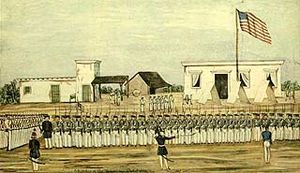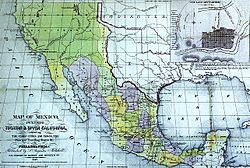Siege of La Paz facts for kids
The Siege of La Paz was an important event during the Mexican–American War. It happened in a city called La Paz, Baja California Sur in Mexico. During this time, Mexican fighters tried to take back their city from the United States Army. The fight lasted for twelve days in November and December 1847.
Quick facts for kids Siege of La Paz |
|||||||
|---|---|---|---|---|---|---|---|
| Part of the Pacific Coast Campaign | |||||||
 Marines raising the American flag over La Paz, Mexico, 1847. |
|||||||
|
|||||||
| Belligerents | |||||||
| Commanders and leaders | |||||||
| Strength | |||||||
| 115 infantry | ~500 militia | ||||||
| Casualties and losses | |||||||
| 1 wounded | ~36 killed 60 deserted |
||||||
Why Did the Siege Happen?
The Mexican Army had a leader named Manuel Pineda Muñoz. He was gathering Mexican farmers and other people to fight in the war. His group, called a militia, had already lost two battles. These were the Battle of La Paz and the Battle of San José del Cabo.
Captain Pineda wanted to keep fighting. He decided to try again at La Paz. He hoped to win this time and take the city back.
At this time, the American forces in La Paz were 115 men. They were called the New York Volunteers. These soldiers were from New York. Their leader was Henry Stanton Burton. They had arrived peacefully in La Paz on July 21st.
The United States Navy did not have any warships nearby. All their ships had sailed north for orders. Other ships had left to get supplies. This meant the American soldiers in La Paz were on their own. They could not leave the city if they needed to.
The Fight for La Paz

Captain Pineda's group grew to about 500 fighters. They even had a small cannon. On November 21st, they attacked the city. The fighting lasted for several hours.
Pineda's men tried to attack from the east and south. But the American soldiers pushed them back each time. On November 28th, Pineda's men took over the old Mexican barracks. They raised a Mexican flag there. However, the American soldiers quickly fought back and took the building again.
On December 8th, help arrived for the Americans. A small boat came from Mazatlán with supplies. Then, a ship called the Cyane also arrived. When Pineda's men saw the ship, they decided to leave. They went to a place called San Antonio. The siege was over.
What Happened After the Siege?
Even though the siege of La Paz was over, Captain Pineda's fight was not finished. He moved on to attack another city, San José del Cabo, soon after.
An American officer, Tunis Craven, later described La Paz. He said that the parts of the town not protected by the soldiers were burned. Many plants like grapevines and fig trees were destroyed.
While the siege was happening, the American President, James K. Polk, spoke to the Congress. This was on December 7th, 1847. He said that American forces had taken over New Mexico and California. He stated that these areas were now under American control. President Polk also said that these lands should never be given back to Mexico.

